Related Research Articles

The flags of the Confederate States of America have a history of three successive designs from 1861 to 1865. The flags were known as the "Stars and Bars", used from 1861 to 1863, the "Stainless Banner", used from 1863 to 1865, and the "Blood-Stained Banner", used in 1865 shortly before the Confederacy's dissolution. A rejected national flag design was also used as a battle flag by the Confederate Army and featured in the "Stainless Banner" and "Blood-Stained Banner" designs. Although this design was never a national flag, it is the most commonly recognized symbol of the Confederacy.
Sic semper tyrannis is a Latin phrase meaning "thus always to tyrants". It suggests that bad, but justified outcomes should, or eventually will befall tyrants.

Henry Alexander Wise was an American lawyer and politician from Virginia. He was a U.S. Representative and Governor of Virginia, and US Minister to Brazil. As Governor, he was much involved in the 1859 trial of abolitionist John Brown. During the American Civil War, he was a general in the Confederate States Army. He was the father of Richard Alsop Wise and John Sergeant Wise, who both served as U.S. Representatives.

The Richmond Times-Dispatch is the primary daily newspaper in Richmond, the capital of Virginia, and the primary newspaper of record for the state of Virginia.

Libby Prison was a Confederate prison at Richmond, Virginia, during the American Civil War. It gained an infamous reputation for the overcrowded and harsh conditions under which officer prisoners from the Union Army were kept. Prisoners suffered from disease, malnutrition and a high mortality rate. By 1863, one thousand prisoners were crowded into large open rooms on two floors, with open, barred windows leaving them exposed to weather and temperature extremes.
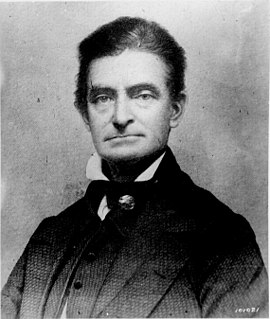
Virginia v. John Brown was a criminal trial held in Charles Town, Virginia, in October of 1859. The abolitionist John Brown was quickly prosecuted for treason against the Commonwealth of Virginia, murder, and inciting a slave insurrection, all part of his raid on the United States federal arsenal at Harpers Ferry, Virginia. He was found guilty of all charges, sentenced to death, and was executed by hanging on December 2.
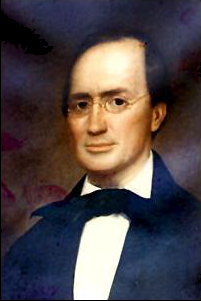
William Tappan Thompson. He co-founded the Savannah Morning News in the 1850s, known then as the Daily Morning News. One of his most notable works was Major Jones's Courtship, an epistolary novel. Thompson's best-known fictional character was Major Joseph Jones.
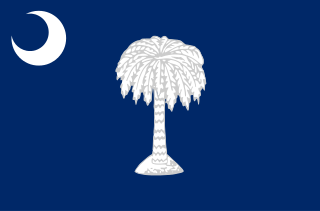
South Carolina was the first state to secede from the Union in December 1860, and was one of the founding member states of the Confederacy in February 1861. The bombardment of the beleaguered U.S. garrison at Fort Sumter in Charleston Harbor on April 12, 1861 is generally recognized as the first military engagement of the war, and the retaking of Charleston in February of 1865, and raising the flag again at Fort Sumter, was for the Union the symbol of victory.

Virginia became a prominent part of the Confederacy when it joined during the American Civil War. As a Southern slave-holding state, Virginia held the state convention to deal with the secession crisis, and voted against secession on April 4, 1861. Opinion shifted after April 15, when U.S. President Abraham Lincoln called for troops from all states still in the Union to put down the rebellion, following the capture of Fort Sumter. The Virginia convention voted to declare secession from the Union on April 17. A Unionist government was established in Wheeling and the new state of West Virginia was created by an act of Congress from 50 counties of western Virginia, making it the only state to lose territory as a consequence of the war.

The National Intelligencer and Washington Advertiser was a newspaper published in Washington, District of Columbia from October 30, 1800 until 1870. It was the first newspaper published in the District, which was founded in 1790. It was originally a Tri-weekly publication. It covered early debates of the United States Congress. The paper had a strong bias to Republicans and Thomas Jefferson.

Johnston Livingston de Peyster was a soldier in the Union Army during the American Civil War and later a member of the New York State Assembly from Dutchess County, New York. The son of a wealthy old Dutchess County family, de Peyster joined the Union Army at the age of eighteen. He saw service in the eastern theater, and is best remembered for raising the first Union flag over the Confederate capitol of Richmond, Virginia, after its fall in 1865.
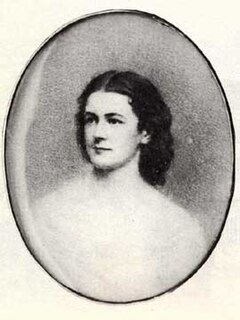
Hetty Carr Cary was the wife of CSA General John Pegram and, later, of pioneer physiologist H. Newell Martin. She is best remembered for making the first three battle flags of the Confederacy. Hetty was related to two of Virginia's most influential families, the Jeffersons and the Randolphs. She was also a lineal descendant of Pocahontas.

John Brown's raid on Harpers Ferry was an effort by abolitionist John Brown, from October 16 to 18, 1859, to initiate a slave revolt in Southern states by taking over the United States arsenal at Harpers Ferry, Virginia. It has been called the dress rehearsal for, or Tragic Prelude to, the Civil War.
Lawrence Berry Washington was an American lawyer, military officer, author, Forty-niner, border ruffian, and a member of the Washington family. Washington was born on his family's Cedar Lawn plantation near Charles Town, Virginia and was the eldest of 13 children. He practiced law, then served as a second lieutenant in the Virginia Volunteers during the Mexican–American War. During his service in the war, Washington reportedly wore the sword of his great-granduncle George Washington.
The Telegraph was a newspaper in Adelaide, South Australia, founded in 1862, and merged with The Express to become The Express and Telegraph, published from 1867 to 1922.

The Richmond Examiner, a newspaper which was published before and during the American Civil War under the masthead of Daily Richmond Examiner, was one of the newspapers published in the Confederate capital of Richmond. Its editors viewed strong executive leadership as a threat to the liberties of its subscription readership. The paper published staunch and increasingly vitriolic opposition to the leadership and policies of Confederate President Jefferson Davis. Historians often consult the pages of the Examiner for insights into the growing problems faced by the Davis administration and the South as they faced the increasing prospect of defeat in the Civil War.
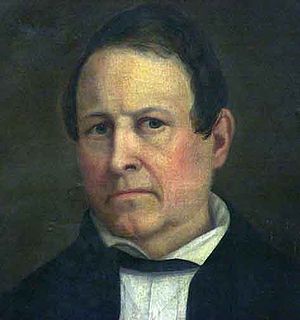
Isaac R. Harrington was a prominent businessman and entrepreneur in Burlington, Vermont and Buffalo, New York. He became active in politics as a Whig and served as mayor of Buffalo from 1841 to 1842.
The Winchester Medical College (WMC) building, located at 302 W. Boscawen Street, Winchester, Virginia, along with all its records, equipment, museum, and library, was burned on May 16, 1862, by Union troops occupying the city. This was "retaliation for the dissection of cadavers from John Brown’s Raid". More specifically, it was in retaliation for the desecration they discovered of one of those cadavers, the body of one of John Brown's sons, identified years later as Watson. The body of John Brown's son, fighting against slavery in the raid on Harpers Ferry, had been dishonored: made into an anatomical specimen in the College's museum, with the label "Thus always with Abolitionists". In addition, students at the school collected and then dissected the bodies of three other members of Brown's troop, and a black boy was apparently tortured and killed there for favoring the Union.
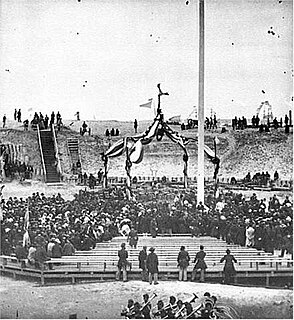
Raising the Flag at Fort Sumter was a ceremony—a newspaper called it a "performance"—that took place at Fort Sumter, in the harbor of Charleston, South Carolina, on Friday, April 14, 1865, four years almost to the day after the Fort Sumter Flag was lowered at the beginning of the American Civil War. General Lee had surrendered at Appomattox on Sunday, April 9. It was intended to symbolically mark and celebrate the Union victory and the end of the war.
References
- ↑ "(Untitled)". Evening Whig. April 6, 1865. p. 2. Archived from the original on November 29, 2020. Retrieved November 21, 2020– via newspapers.com.
- ↑ "The Duries of the Hour. Our deliverance from Tyranny". Evening Whig (Richmond, Virginia). April 7, 1865. p. 1. Archived from the original on November 29, 2020. Retrieved November 21, 2020– via newspapers.com.
- ↑ Associated Press (April 7, 1865). "Washington". Evening Whig (Richmond, Virginia). p. 2. Archived from the original on November 29, 2020. Retrieved November 21, 2020– via newspapers.com.